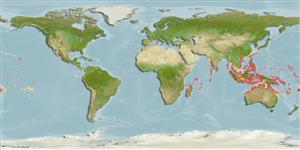>
Gobiiformes (Gobies) >
Gobiidae (Gobies) > Gobiinae
Etymology: Exyrias: Derived from Greek, xyreo = to shave (Ref. 45335); belissimus: Genus misspelled..
More on author: Smith.
Environment: milieu / climate zone / depth range / distribution range
Ecología
marino asociado a arrecife; rango de profundidad 1 - 30 m (Ref. 90102). Tropical; 30°N - 30°S
Indo-West Pacific: East Africa to Samoa, north to Yaeyama Islands, south to Fiji.
Tamaño / Peso / Age
Maturity: Lm ? range ? - ? cm
Max length : 15.0 cm SL macho / no sexado; (Ref. 48637)
Espinas dorsales (total): 7; Radios blandos dorsales (total): 10-12; Espinas anales 1; Radios blandos anales: 9 - 10; Vértebra: 26. Dorsal half of body brown, ventral half yellow, with 7-8 dark brown bars. Small silvery white spots on cheeks and opercula. Predorsal scales 8 or 9. Usually, spines on 1st dorsal fin elongated into filaments with the 3rd and 4th typically longest; spine of 2nd dorsal fin with red and white alternating bands, spots on rays and membrane. Cycloid scales only on nape and isthmus. Cheeks and opercula fully scaled. Teeth small and tightly packed in jaws. Depth of body about 3.6-3.9 in SL (Ref. 90102).
A territorial species that inhabits lagoon and seaward reefs (Ref. 9710, 48637). Found over silty bottoms near or under overhanging corals. Feeds by sifting the sediment through its gill rakers (Ref. 1602).
Life cycle and mating behavior
Madurez | Reproducción | Puesta | Huevos | Fecundidad | Larva
Murdy, E.O., 1985. A review of the gobiid fish genera Exyrias and Macrodontogobius, with description of a new species of Exyrias. Indo-Pac. Fish. (10):14 p. (Ref. 403)
IUCN Red List Status (Ref. 130435)
Threat to humans
Harmless
Human uses
Acuario: Comercial
Más información
Nombres comunesSinónimosMetabolismoDespredadoresEcotoxicologíaReproducciónMadurezPuestaAgregación para la puestaFecundidadHuevosEgg development
ReferenciasAcuiculturaPerfil de acuiculturaRazasGenéticaElectrophoresesheritabilidadEnfermedadesProcesamientoNutrientsMass conversion
Herramientas
Special reports
Download XML
Fuentes de Internet
Estimates based on models
Preferred temperature (Ref.
123201): 26.2 - 29.3, mean 28.6 °C (based on 2723 cells).
Phylogenetic diversity index (Ref.
82804): PD
50 = 0.5312 [Uniqueness, from 0.5 = low to 2.0 = high].
Bayesian length-weight: a=0.00708 (0.00390 - 0.01284), b=3.05 (2.89 - 3.21), in cm total length, based on LWR estimates for this species & (Sub)family-body (Ref.
93245).
Nivel trófico (Ref.
69278): 2.8 ±0.30 se; based on food items.
Resiliencia (Ref.
120179): Medio, población duplicada en un tiempo mínimo de 1.4-4.4 años (Preliminary K or Fecundity.).
Fishing Vulnerability (Ref.
59153): Low vulnerability (10 of 100).
Nutrients (Ref.
124155): Calcium = 88.7 [47.7, 165.5] mg/100g; Iron = 0.717 [0.373, 1.276] mg/100g; Protein = 18.3 [16.3, 20.0] %; Omega3 = 0.134 [0.064, 0.222] g/100g; Selenium = 23.6 [13.5, 44.1] μg/100g; VitaminA = 117 [31, 370] μg/100g; Zinc = 1.84 [1.26, 2.67] mg/100g (wet weight);
